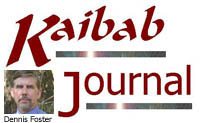|
|
|
|
Grand
Canyon Parking: by Dennis Foster (February 2004) |
|
|
|
|
| For years, I been critiquing the transportation plans being put forth by officials at Grand Canyon National Park. I was asked to submit a paper to the Goldwater Institute, which they published as Grand Canyon Transportation Planning: The Railroading of Visitors in October of 1999. Over the years, I have also given many special lecture presentations on this topic at NAU. And, while I have offered up some differing solutions to the parking problem, the one that was likely to strike the most responsive chord was to increase the existing infrastructure. Still, I would get asked, "Exactly what would you do?" about creating new parking and I didn't have a specific answer. I didn't think it was really that difficult an exercise. But, if the debate starts to hinge on a specific alternative for parking, I decided that it was worthy of extended analysis and that specifics should be offered up for consideration. This proposal went through a couple of early drafts. Copies of it were handed off to Senator Kyl and taken to other members of the Arizona Congressional delegation, although I have not heard any response from them on this topic. | |
|
|
|
|
For
the last 25 years, congestion at the Grand Canyon’s South Rim has been
growing. This has been exacerbated by an unwillingness to make major
improvements to the infrastructure at the park to better accommodate
visitors. Since 1997, the National Park Service (NPS) has
aggressively pursued a proposal to require that visitors park nearly seven
miles from the rim and take a train into the developed area of Grand
Canyon. In the fall of 2000, the U.S. Congress halted the efforts of
the NPS in this regard and required that new studies be conducted on this
issue. It was expected that a new environmental assessment of
various transit alternatives would be undertaken by park service
officials. Although nearly four years have passed since then, such
an evaluation has yet to be released. The purpose of this proposal
is to have any such environmental assessment revisit the idea of dealing
with congestion primarily through expanded infrastructure inside the park.
This solution not only represents the lowest cost alternative, both to the
NPS as well as to the visitor, but it also reflects the desire of visitors
to enjoy the Grand Canyon in a convenient manner without degrading the
quality of their experience.
Background In the early 1990s, the
National Park Service was engaged in a process of constructing
forward-looking plans for the management of Grand Canyon, which became
formalized in the General Management Plan (GMP) [1].
Part of this planning process involved transportation in, and around, the
park. Of special concern was the excess demand for parking at the
peak level of visitation [2].
Forecasts for parking demand to the year 2010 are shown in Appendix 1.
At the time, it was thought that visitation to the park would likely grow
at about 2.5 percent per year [3].
When the GMP was finalized, the park service had decided on building a
large parking facility near their new visitor center (Canyon View
Information Plaza) which would accommodate off-peak and shoulder seasons,
but which would fill up during the busy summer months. The overflow
would be diverted to a parking lot in the community of Tusayan, at the
park’s boundary and about seven miles from the rim. From there,
visitors would board shuttle buses in order to enter and exit the park. In
1997, prior to the construction of the new visitor center, the park
service issued the Mather Point Environmental Assessment. At that
time, the park service abandoned its earlier decision to accommodate
parking inside the park [4].
Instead, all day use visitors would have to park in Tusayan. This
Environmental Assessment primarily studied differing mass transit plans
– buses versus trains – for getting visitors into, and out of, the
park. Ultimately, the park service rejected the bus alternatives,
and adopted a proposal to build a light rail system between Tusayan and
the rim. In the
fall of 2000, the park service had pared down the group of potential
bidders for this project, and was about to issue a “request for
proposals.” At this time, the anticipated capital cost for a
rail system had grown to $200 million. The U.S. Congress intervened
in this process, halting any additional development in this regard, until
a further study could be completed about the viability of alternative
transport modes. The next step in the process requires that the park service pursue another environmental assessment of differing transport alternatives. While the NPS is considering their previous transit choices, there is an effort underway to get them to expand their selections to include an express rail service from Williams, Arizona, about sixty miles from the park. [5] Consequently, this may be a window of opportunity to revisit the issue of dealing with the congestion by simply providing more parking at Grand Canyon. Certainly, once the estimated $200 million is spent on altering the infrastructure to a rail system, it will be next to impossible to have this decision undone. [1]
This document can be found at: http://www.nps.gov/grca/gmp/index.htm |
|
|
|
|

